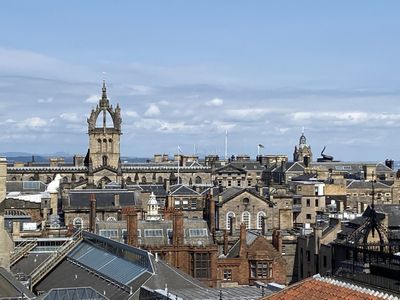
I don't eat much when it's hot out. And whoo-boy is it hot out. Record temperatures across Europe and into the UK. Over 40C in London, which is record setting and either the end of the world, or a happy excuse to eat ice cream, depending on which British tabloid you read.
We escaped the worst of the heat since we had a train ticket to Edinburgh, Scotland (established 7th century AD, population 543 000, temperature 32C) on the morning train from Port Sunlight. Lucky it was a morning train too, since the Rail Network started cancelling trains at noon due to the heat. Officials were worried that the heat outside plus the heat generated by the electric trains would cause transformers to blow and the tracks to buckle.
But hey, grab an ice cream and head to the beach, right?
We only had 48 hours in Edinburgh and we were determined to make the most of it, Travel Man style, so we dropped our bags and headed out again. We avoided the afternoon heat and crowds in the Old Town and took the bus to Stockbridge, northwest and downhill from the castle. It's an up and coming area with a mix of houses and funky shops. We had lunch at an excellent Scandinavian bakery called Soderberg - simple yet awesome sandwiches, lots of iced tea and a Kanebuller (Swedish cinnamon bun) - and then tried our best to walk along the Water of Leith toward Dean Village (a medieval village beside the medieval city)

Smart, eh? When it's hot, walk along the water! Well, there wasn't much water in the river, if I'm honest, and there isn't much of a pathway along what water there is. We were expecting shade and benches, and they might be there, but we missed them. We eventually made it to the Modern Art museum and found a patch of shade on the wide lawn. It was 5pm now and the museum was closing, but we checked our map and realized that if we had left Stockbridge at a 90 degree angle to our route, we could have visited the Royal Botanical Garden. Definitely shade there!
The gardens were a 20 minute walk away, so we decided to go for it, not realizing that they close at 6pm. We made it just as they closed. Sigh. Defeated, we looked for a bus back to our room and found that the stop was at the opposite gate into the gardens! We couldn't cut through, so we hiked around the circumference of the massive gardens, along a busy streets, in full sun, with lovely shade trees just out of reach, beyond a tall wrought iron fence. But we made it to our hot room, hot and sweaty ourselves. Supper was a couple of sandwiches and crisps picked up from a nearby convenience store, eaten on two chairs in front of our guest house, where we could catch a slight breeze as old Sol set for the day.
By morning our heads had cleared and we had our travel chops again. Up early and bussed into Old Town, where we found an awesome coffee shop called Hideout Cafe, tucked into a corner just off Lawnmarket Street. More excellent coffee and cinnamon buns there (I'm quite taken by Scandinavian cinnamon buns - lighter, less gooey and prettier than our Canadian counterparts.)
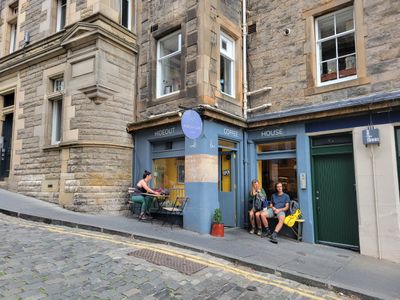
We poked about Old Town and the Royal Mile as the streets were waking up for the day. Lots of window shopping and watching folks set up shop. It's our favourite time to check out the real touristy areas, as we've been and gone before the crowds arrive. And watching everyone set up their stores reminds me of getting the bakery set up in the morning, which was a favourite part of the day too..

The centre of Edinburgh is split into two parts: Old Town and New Town. Old Town is the medieval part, up high on the hill, surrounding the castle. The castle stands proud above all, perched upon a sheer cliff face. The streets around the castle are tight and twisty and lovely, having been formed over hundreds of years to support the castle and the nobles who lived there. The Royal Mile is the ancient High Street; the shopping district that has existed as part of old town for ages and ages.

By the mid 1700's, commerce and colonies were rising above the feudal lords, and the new nobility built a New Town to live in, at the bottom of the hill, beside the medieval fortress. The New Town was laid out in the Georgian manner, with straight streets in a grid pattern and large town squares at either end. And in modern times, Old Town and New Town are a tourist's dream, as you're able to walk between hundreds of years of history in 10 minutes. It's a trip, for sure.
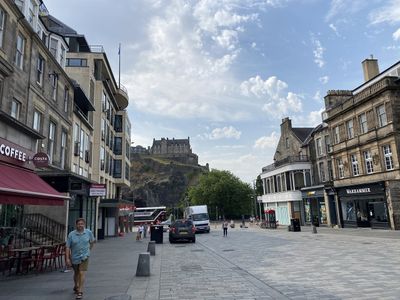
We walked through both, of course, and the contrast of architectural styles were stunning. It was also interesting to see how the modern commerce has affected each area. Old Town is all about Ye Olde Scotland. That's where you go to get your tweed and eat haggis and buy your Scotland souvenirs. New Town is where all the big international brands gravitate. If you want to eat at TGI Fridays, you go to New Town. If an M&M store ever opens here, I bet it will go to New Town.
And yet, New Town is also where the funky, modern clubs and restaurants are as well. We walked through at mid-day, but it sure looks like it would be hopping come nighttime.
Between Old Town and New Town, halfway up the hill, are some important institutions like the National Library, the Royal Scotland Museum and yes, the central train station. Because of the huge hill in the centre of the city, it's possible to take all of this in at once. Edinburgh is a city of layers to me, and I love it.
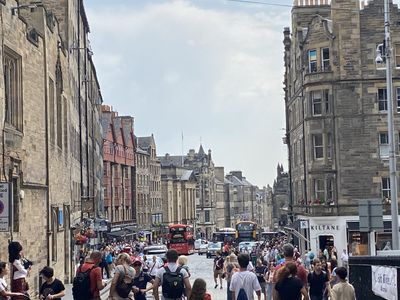
We climbed back up to the Royal Mile and headed down and east towards Leith. There's a wide street called Leith Walk that takes you all the way to the harbour and it's fascinating. This seems like a more working class / proper neighbourhood, so the shops are all tiny restaurants and grocers and newsagents and the like. Although we did find a stellar bookstore (Topping and Company - highly recommended) where I picked up The People's History of Scotland.
Several blocks along Leith Walk were full of Italian stores and we stopped at a tiny shop for lunch. Two tables out front, one occupied by four older gentlemen who look like they are permanent residents of that table. We ordered two sandwiches and knew they'd be good when the clerk called in one of the old men to come and make them for us. They were perfect. Simple ham and cheese on a soft panini roll. Simple is best, especially on a hot day.
We tried to catch a cool sea breeze along the Edinburgh docks, but construction and a dead calm defeated us, so we got on a bus and headed back towards our guest house, stopping at The Meadows. It’s a massive green space which, on this hottest of days, was full of young people hanging out, drinking, barbecuing and trying to stay cool. We found a shady spot and hung out, drinking the last of our water, emptying our packs of snacks, and reading our books, while the ol’ Sol slid down to a reasonable angle.
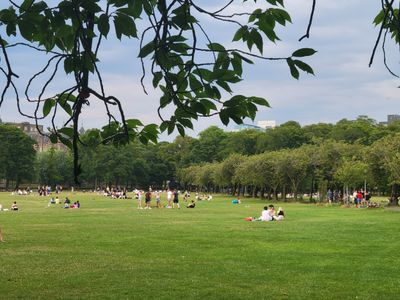
I was fascinated by all the portable, disposable bbq’s in use in the park. They are tiny hibachi grills, consisting of nothing more than a pie plate, a thin screen and some charcoal briquettes. There were dozens and dozens fired up in the park, including all over the cricket pitch. While they seemed to heat the meat well (and the plant based meat too), there were more than a few mishaps. We saw lots of charred, rectangular divots on the grass as we left the park. We saw bins for disposing the cold remains too, although most of the bin lids were melted. Still, they look like a lot of fun.
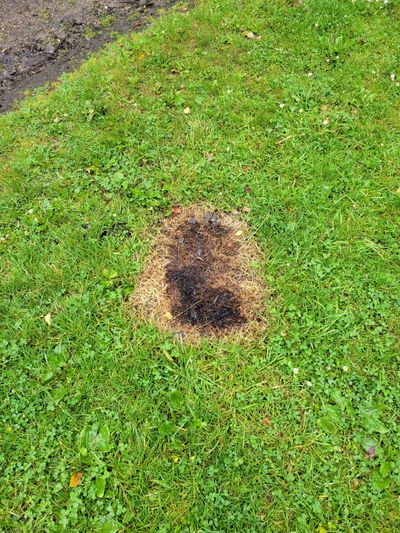
By our final morning in Edinburgh the heatwave was starting to break. We had a few hours before our train so stopped in at two excellent exhibits. The National Library is displaying the winners of a special bookbinding competition. These are custom bindings, where the designs on the leather work and book jackets match the book. Stunning creativity and craftsmanship.
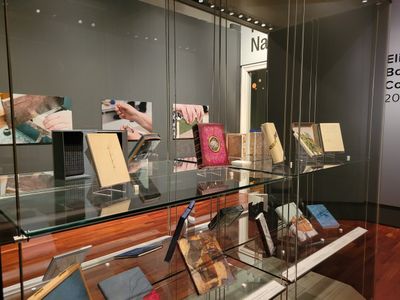
And then we hopped over to the Scottish Museum for a fascinating exhibit about the history of typewriters. There were early prototypes, oddball alternatives which didn't find a market, and then sleek, modern typewriters (well, modern if you consider the 1960's modern!)
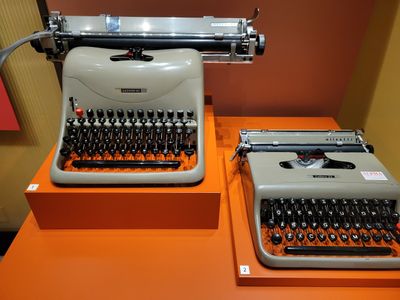
I learned that most of the typewriters which were sold in the UK and Europe post WWII were manufactured in Glasgow, so there's a Scottish connection there. And the exhibit spent a lot of time showing how portable typewriters were a form of emancipation for women in the early 20th century, from giving young women the means for good employment, to spreading the word in print for social movements including the Suffragettes. There was even a display of typewriter art - impressionistic artwork all made with a portable typewriter. It was a fascinating exhibit, lovingly curated, and has me wanting to trade in my keyboard for a Smith Corona and a ream of paper.
And then we were off. One more sandwich, this time a bagel purchased to eat on the train. We had people waiting for us in Glasgow.